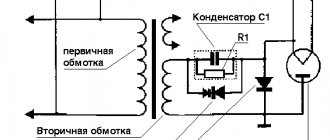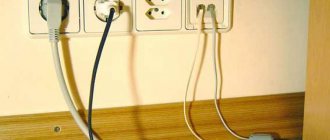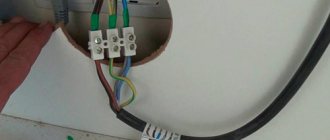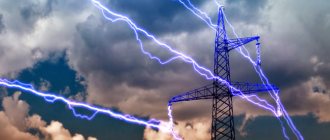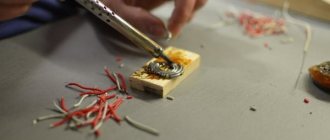Need to ground myself
An equally important reason why the bird is not shocked is the lack of grounding. What exactly is an electric shock? This is the moment when charged particles pass through a living being if it completes a circuit, becoming a conductor for a while.
For example, a person can easily stand on a rubber mat and insert a nail into a socket, with virtually no risk of receiving an electric shock (but it’s better not to do this at home!!!). But as soon as he touches some metal object with his hand, charged particles instantly rush towards this object, and through a living body, often leading to its death.
Do birds have grounding? Of course no! They just sit on one wire and there is nowhere for the current to go through them. What happens if grounding occurs? Of course, the bird will die instantly - after all, a discharge of thousands or even tens and hundreds of thousands of volts will pass through it. Most often this happens with large birds - eagles and others. But they don’t just sit on the wires, holding them tightly with both paws - in this case, nothing will probably happen to them. But if a proud eagle sits on a wire, holding onto it with one paw, and touches, for example, a metal support with the other or its wing, it will create an additional circuit through which the current will immediately flow. The consequences for the bird will be very sad.
However, in recent years, in order to avoid this, several meters of wire in the immediate vicinity of the support are covered with special insulators. Sitting on them, the bird can try to close the circuit all day long - this will not harm it.
How to protect people and birds from electric shock?
Electric current is a dangerous “enemy” that should not be trifled with. To protect you and explain how you can prevent birds from harm, I will give some practical advice in this direction.
| Adviсe | Description |
| Tip #1. | Never touch exposed wires. Even if you need to check if the electricity has gone out. There is a special indicator for such manipulations. |
| Tip #2. | Even if the situation is desperate and you need to touch part of the wire (say, during a repair), do it only with the back of your hand. If you touch it with your palm, you will be “short-circuited” from the electric shock and you will not be able to open your hand. |
| Tip #3. | Always turn off the power when carrying out wiring repairs. Don't joke and don't think it will work out. Your life is on the line. |
| Tip #4. | To keep our feathered friends safe, make sure that authorized agencies install “bird guards”—small devices that prevent birds from landing on dangerous wires. Nowadays, the trend towards installing them is gaining momentum, but not too quickly. |
Bird protection devices on wires
Important: an electric current of 0.1 A can cause irreparable harm to a person - the functioning of the heart can be impaired, which will lead to death. To avoid electrocution, always follow safety rules and do not take risks. Even if you think that by standing on something other than the ground you have a chance of avoiding the blow, remember that this probability is negligible.
Explanation of why birds on wires are not shocked:
A few words about potential difference
It would not be amiss to talk about the potential difference and the step voltage associated with it. But first things first.
What is tension? Another name for it is potential difference. For example, in simple sockets, which are found in every apartment and house, it is 220 volts. That is, on one contact the potential is 220 volts, and on the other - 0. That is why they are called “phase” and “zero”. As long as they are separated from each other, nothing happens - that is why the potential difference remains constant - 220 volts. But what happens if you close this circuit, for example, by plugging in a refrigerator plug? Of course, charged particles will run along the wire, start the motor and the lighting of the refrigerator, and only the unused voltage will go to “zero”.
In principle, a power line works in exactly the same way. Near the power plant, the voltage is simply enormous - thousands, and sometimes hundreds of thousands of volts. But at the opposite end there is zero. Of course, charged particles with enormous speed (the speed of light!) will rush from phase to zero, along the way launching all devices plugged into sockets - from light bulbs in entrances to huge factories. This is ensured by the potential difference at different ends of the power line. What does this have to do with the topic of our article? The most immediate thing - just be patient for a few more lines.
Now let's look at what step voltage is. This is the name for the difference in potential between the points connected by the legs of a person (or a bird, any animal). The greater the distance between the points, the higher the potential difference. This is why experts recommend that people who find themselves in an electric shock zone move in small steps and certainly not run.
This is also true for birds. If the potential difference at the beginning and end of a 1000-kilometer power line is 1 kV, then there is only 1 volt per kilometer. And if we take the distance between the birds’ legs to be about 5 centimeters, then the difference will be only 0.000005 volts. Of course, if the bird receives such a discharge, it will not even feel a slight tingling in its paws. Well, she won’t be able to put her paws wide enough to die from an electric shock, even if she wanted to.
Why don’t the elementary laws of physics apply to humans?
Who told you that they do not apply to humans?
The fact that a person gets an electric shock when touching a bare wire does not mean at all that he is deprived of “bird superpowers.” I'll explain with an example. Let's imagine the same picture, only with a person. So, a man stands on the ground and touches the wire with his hand. What will happen? That's right, he'll get an electric shock. But why?
Because a person stands on the ground, which means he becomes a conductor of electric current from one potential to another. After all, the earth is a potential with a minimum of charged particles, and a wire is a potential with a maximum. So it turns out that when you touch a person standing on the ground, the circle closes and an electric current passes.
Did you catch the difference between a bird and a person? That's right, the bird flies and doesn't touch any potential other than the wire. And a person stands and is simultaneously connected with two potentials.
But what would happen if a person had wings and flew like a bird? It is likely that the reaction would have been the same as in the case of the bird - it would not have happened. In this case, a person would also become a potential, just like a bird.
But a person cannot fly, so there is no point in thinking about this theory. Fortunately, humanity has come up with a lot of technology that can allow a person to touch electricity without harm to health.
Horse accident
Speaking about step voltage, it is worth recalling one instructive incident that took place in Leningrad in 1928. It perfectly illustrates this physical phenomenon and has received its own name - Horse Crash.
This happened in the middle of a square lined with hexagons made of wood. There was a cast iron well, inside of which there was a 2 kV disconnector. Over time, the insulator simply cracked, causing the disconnector to hang a few centimeters from the wall. Probably, this would not have been noticed for a long time if it had not been for the rain.
After heavy rainfall, the wooden pavement became not only pliable, but also conductive. While people walked along it, nothing terrible happened. But when a heavily loaded cart passed near the well, the pavement surface buckled, causing the wire to short-circuit on the well, releasing 2000 volts to the environment.
People whose step was less than a meter simply received a relatively mild electric shock. But the horse pulling the cart was less fortunate. Firstly, her hooves were equipped with metal horseshoes that perfectly conduct current. Secondly, the distance between the horse’s legs was more than one and a half meters. As a result, the electric shock simply killed her on the spot. Moreover, this whole incident took no more than two seconds - after that the “automatic machine” worked.
What happened was able to interest people, including servants of the law - a horse patrol consisting of two policemen arrived at the place of the mysterious death of the animal. By this time, the duty officer at the substation checked whether everything was in order with the insulation and decided that the shutdown had occurred accidentally, and immediately turned on the current. As a result, people standing or walking in the square again received a small shock, but both police horses died on the spot.
By the way, exactly the same incident happened in our time in Great Britain. In Berkshire, there is a popular racetrack under which the underground cable finally leaked in 2011. Several horses also died due to the accident, but the people present were not injured.
Birds can cause accidents on electrical networks
A flock of birds taking off from the wires - and this is what came out of it
Birds aren't the only ones that can be harmed by electricity. A person can also be harmed by birds, which can cause accidents on electrical networks.
When an electric current kills a bird, it is, of course, very pitiful. Stupid beautiful creature! But at the same time, the discharge of electricity at the moment of electric shock can turn off electrical equipment. Thus, a bird dying can leave a lot of people and important equipment without electricity.
In general, the problem of sudden power outages is a separate issue. There are many examples where you cannot turn off the electricity. Nuclear power plants, for example, cannot be de-energized. The surgical operating room where the operation is taking place cannot be left without electricity. And much more.
Nevertheless, accidents do happen. Sometimes they can be provoked by birds, as shown in the video above. Although, of course, more often shutdowns occur for completely different reasons.
The main thing is that the most critical electrical networks are not overhead, but underground, for example. It's more reliable. Networks need to be duplicated. They also install additional autonomous sources of electricity, for example, in every hospital where there is surgery.
Birds sit on wires and get hit by a high voltage breakdown
“Hey, darling, what’s wrong with you?!” – Bird... it’s a pity... (From the film “Prisoner of the Caucasus”)
The wire may carry very high voltage. So high that any creature on the wire, with its small size, reduces the distance between the wires. And then an electrical breakdown is possible.
What kind of lighting do you prefer?
Built-in Chandelier
Air is a poor conductor of electricity. So bad that wires located far apart from each other have no effect on each other. But still, air, albeit a little, conducts electricity.
This means that the closer the wires are located, the greater the likelihood that the electric current will pass directly through the air. The lightning effect occurs: a discharge of electricity in the atmosphere. This means that electric current has flowed through the air.
So, if a bird sits on a wire or on a pole, then with its body it shortens the distance between the wires or between the wire and the ground. The pillar is also a kind of continuation of the earth, for it is buried in the ground. And then, if the voltage is very high, the electric current will flow through the bird from one wire to another wire or into the ground, or into a pole buried in the ground.
We see such an unfortunate bird in the video above. As soon as the woodpecker sitting on the pole turned its head and thereby shortened the distance to the high-voltage wire by millimeters, a fatal discharge of electricity immediately occurred.
Why do birds sit on wires? In fact, they are taking a lot of risk by sitting on the wires. But they have no idea about it. There were no man-made electrical wires in nature, and birds do not have a generational memory of danger. This means that people should take care of them and prevent birds from landing in dangerous places. But such protection is, alas, not always and not everywhere.
Explanation using an example from life
Imagine if you needed to go to your local store to buy bread and milk. You can choose one of two possible routes: along a nice flat path or through a muddy swamp. Most likely, you will choose the walking path because it is much easier to walk along. This is exactly what electricity does, it moves along the simplest path, which we call the path of least resistance. Engineers specifically design wires so that electricity moves easily through them.
On the other hand, our bodies and the bodies of birds offer great resistance to the electricity flowing down them. Therefore, the electricity will preferentially continue down the wire, since this is an easier path for it to take than passing through the bird. It's for these reasons that our feathered friends can happily sit on power lines without turning into rotisserie chickens.
When does it “jerk” with an electric shock?
Note that birds still sometimes die when using wires as a perch. This occurs when some third point (usually the wing) comes into contact with another wire or pole supporting the line. In both cases, a potential difference occurs and current begins to flow through the bird's body. This most often happens with relatively large birds like crows, whose wingspan may be greater than the distance between the wires.


